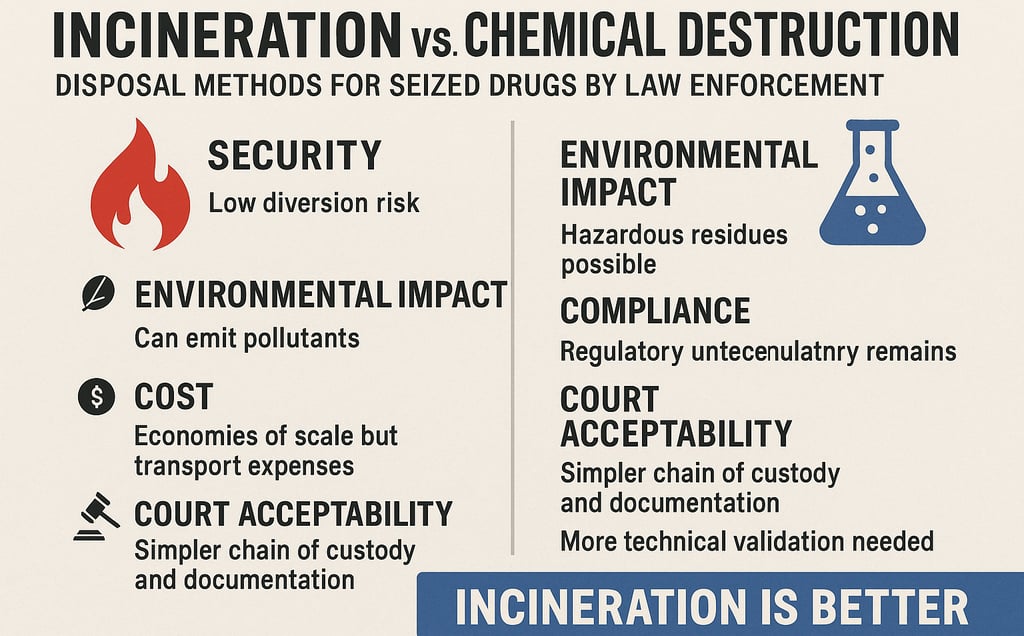Incineration vs. Chemical Destruction: Which is Better for Law-Enforcement Disposal of Seized Drugs?
Evaluating incineration versus chemical destruction of contraband drugs.
DRUG DESTRUCTION
Dr. Kyle C. Murphy
10/6/20254 min read


When police seize contraband drugs, they face more than a paperwork problem: they must permanently and safely remove hundreds—sometimes thousands—of doses from circulation while protecting public health, avoiding diversion, staying inside environmental and criminal-evidence law, and keeping costs and operational burdens manageable. Two broad approaches compete in modern practice: thermal destruction (incineration) and chemical destruction (onsite or contracted treatments that chemically render the drug non-retrievable). Below, I compare them across the criteria that matter to law enforcement and conclude—caveated and evidence-based—that incineration is usually the better option.
The objective: “non-retrievable” and auditable
Whatever the technique, regulators and agencies define success as rendering substances non-retrievable and providing a defensible documentary chain of custody and destruction certification. The DEA and related guidance emphasize that destruction must prevent diversion and be documented—whether a registrant ships to a reverse distributor, destroys onsite, or uses a third party. (DEA Diversion Control Division)
Security & anti-diversion risk
Incineration: Low diversion risk. Modern incinerators used for law enforcement or reverse-distributor work are typically point-of-no-return systems: once material is fed to the combustion unit, it is physically destroyed and reduced to ash, and the process can be witnessed or video-recorded for evidentiary purposes. Dedicated onsite incinerators (or contracted transport to permitted combustors) minimize handling steps where theft or substitution could occur.
Chemical destruction: Higher handling/verification burden. Chemical approaches often require additional handling (weighing, mixing, neutralizing, waiting, tertiary stabilization), creating more opportunity for human error or malicious diversion unless strict controls are in place. Some chemical treatments may produce intermediates that must be managed or tested to prove non-retrievability, which complicates custody audits. The DEA has explicitly solicited information about alternatives to incineration, signaling that regulators are still assessing whether chemical methods reliably meet the “non-retrievable” standard. (Federal Register)
Winner (security): Incineration.
Environmental and public-health profile
Incineration: Not uniformly unproblematic. Combustion destroys active molecules but can emit pollutants (e.g., dioxins, particulates, other combustion byproducts) if incinerators are poorly controlled or unpermitted. Permitted hazardous-waste combustors and modern air-control technology mitigate this. Recent regulatory attention (and proposals to strengthen monitoring of municipal and medical waste combustors) highlights that emissions oversight is a live policy issue. (US EPA)
Chemical destruction: Potentially cleaner at point-of-treatment but not risk-free. Some chemical processes produce liquid or solid residues requiring hazardous-waste handling. The opening of drug storage packaging can also create an exposure risk. If chemicals are released to sewer systems without proper validation, they can pose environmental and public-health risks. The net environmental outcome depends on the specific chemical method, whether residues are fully treated, and how transport and containment are handled. (US EPA)
Winner (environmental, conditional): Tie — but only if incineration is done at permitted, well-controlled facilities; otherwise, chemical methods can look preferable on emissions alone. Real-world practice tends to favor incineration when proper emissions controls are available.
Compliance, regulation, and defensibility
Incineration: Straightforward regulatory path. Permitted combustors are already regulated under hazardous-waste and air-quality frameworks; burning with industrial-grade dual-chamber incinerators creates clear documentation and can provide for a Certificate of Destruction that stands up to audit or court scrutiny. Agencies commonly use permitted incinerators for this reason. (DEA Diversion Control Division)
Chemical destruction: Regulatory uncertainty remains. The DEA’s recent requests for information on alternatives to incineration (ANPRM) show regulators are still deciding how to treat chemical methods in the compliance regime. That means law-enforcement agencies that adopt novel chemical techniques may face extra paperwork, testing requirements, and potential skepticism from prosecutors or courts until standards are widely accepted. (Federal Register)
Winner (compliance): Incineration.
Practicality, cost, and logistics
Incineration: Economies of scale, but potential transportation costs. A region facility with a permitted combustor can process large volumes efficiently; per-unit costs fall with scale. Where a combustor is distant, the cost and complexity of secure transport increase—agencies have complained that travel distance to incinerators can be a burden. Mobile industrial-grade incinerators that destroy onsite are a proven solution to the transportation cost issue. Some larger police agencies maintain onsite incinerators to reduce transport, but that brings capital and permitting costs and the need for trained staff. (US EPA)
Chemical destruction: Potential for onsite convenience, lower up-front capital. Chemical kits or onsite systems can avoid transport and be rapid for small batches. But they often require trained staff, hazardous-materials controls, and recurring consumable costs; scale economics are weaker, and long-term costs can exceed expectations when regulatory testing and hazardous-waste disposal are factored in. (Practice Greenhealth)
Winner (practicality): Contextual — small, remote agencies might prefer chemical options for convenience, while larger departments benefit from incineration scale.
Evidence, auditability, and court acceptability
Courts and auditors value simplicity and documentation. A clean chain—seizure, storage, witnessed destruction at a permitted combustor, certificate—maps naturally to courtroom needs. Chemical methods can be defensible, but they require more technical validation to prove non-retrievability; until regulators publish standard protocols, that validation may be more complicated and contestable in litigation. (DEA Diversion Control Division)
Winner: Incineration.
Operational recommendation (practical and prudent)
Default to permitted incineration for major seizures and routine destruction—this minimizes diversion risk and maximizes audit/court defensibility. (DEA guidance and standard practice point this way.) (DEA Diversion Control Division)
Use chemical or alternative methods selectively when transport or use of an onsite permitted combustor is impractical—only after legal counsel and environmental health officers vet the method, and when the agency can document training, QA testing, and hazardous-residue handling. (Federal Register)
Insist on certificates of destruction and robust chain-of-custody procedures regardless of the method. Documentation is the law enforcement version of insurance.
Prefer contracted, permitted equipment to ad-hoc incinerators without proper oversight; environmental and community impacts matter and are increasingly visible in regulation and local politics. (The Guardian)
Conclusion — why incineration wins (with the fine print)
If your decision criteria prioritize preventing diversion, simplifying compliance, creating court-ready documentation, and getting large-volume, consistent destruction, incineration is the better option. It’s the method most clearly aligned with current DEA expectations and with established hazardous-waste regulatory frameworks. That said, the winning strategy for any agency is pragmatic: choose incineration where permitted and practicable; evaluate chemical alternatives only with careful legal, environmental, and operational due diligence; and always keep a strict, auditable chain of custody.
In short, incineration isn’t a perfect panacea for every jurisdictional quirk or environmental concern, but it is the more secure, defensible, and scalable option available to law enforcement today—provided agencies use permitted, well-controlled equipment and keep an eye on evolving emissions and waste-management rules. Think of incineration as the heavy-duty safe in which you lock evidence: not glamorous, but reliable.
Key sources (for further reading)
DEA disposal guidance and FAQs; EPA guidance on collected household medicines and hazardous-waste drugs; Federal Register ANPRM on alternatives to incineration; professional best-practice briefs on drug destruction and audit trails; investigative reporting on how agencies have operationalized destruction. (DEA Diversion Control Division)
One Call We Come to You
+1 702 350 2225
© 2025 LSC Destruction, LLC | Privacy | Terms of Use


1810 E Sahara Ave Ste 75105
Las Vegas, NV 89104

